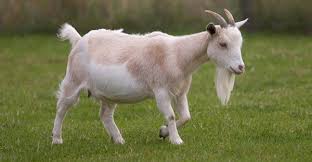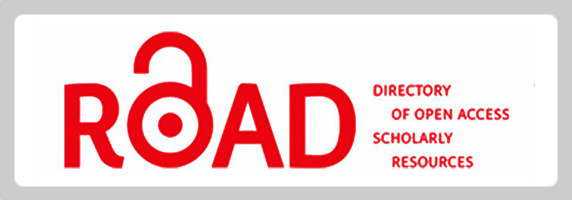Phenotypic Characterization of Indigenous Goats in South Gondar Zone, Amhara Regional State, Ethiopia
Abstract
This study was conducted in South Gondar zone, Amhara regional state, Ethiopia with the objective of phenotypic characterization of indigenous goat population in South Gondar zone. The study was conducted based on visual observation and field measurements. The zone was stratified into highland, midland and lowland agro-ecology and then selected one district from each agro-ecology. Data for visual observation and body measurements were collected from a total of 603 goats (201 per agro-ecology) of both sexes which has one and above pair of permanent incisor (PPI). Observations on qualitative trait were analyzed by using frequency procedure of SPSS version 20 for male and female goat separately. Whereas, body weight and other linear body measurements were analyzed using the Generalized Linear Model (GLM) procedure of SAS Ver.9.3 (2014). Correlation between body weight and other linear body measurements as well as REG procedure to regress body weight from linear body measurement for male and female goats were computed by SAS Ver.9.3 (2014). Most qualitative traits observed in the study area were significantly different and the most dominant coat color pattern was plain in all agro-ecology. White with red was the most frequent observed coat color type in the population. Whereas, white was the most frequent observed coat color in lowland agro-ecology of the zone. Agro-ecology and age group had highly significant (p<0.01) effect on body weight and most of linear body measurements except horn length, rump length, cannon bone length and head length for agro-ecology. Sex of goats had significant effect (p<0.05) on body weight and most of the body measurements except ear length, canon bone length, head length, and rump length. Most quantitative traits showed significantly higher average values in the lowland, than the rest two (highland and midland) agro-ecologies and most quantitative trait of goat population for male were significantly higher than the female one. Body weight was significantly correlated with all continuous traits of both male and female goats but higher in heart girth. As a result, the stepwise regressions revealed that heart girth was the most important variable in the prediction of live body weight. Generally the difference and similarities of indigenous goat in morphometric trait and adaptability should be supported by further study on characterization at molecular level under their production environments.
Downloads
References
Adane Hirpa and Girma Abebe (2008). Economic significance of sheep and goats. Pp. 325-340. In: Alemu Yami and R C Merkel (eds.). Sheep and Goat Production Handbook of Ethiopia.ESGPIP (Ethiopian sheep and goat productivity improvement program). Branna Printing Enterprise. Addis Ababa, Ethiopia.
Ahmed, S. (2013). On-farm phenotypic and production system characterization of indigenous goats in Horro Guduru Wollega zone, western Ethiopia. M.Sc. Thesis Submitted to School of Graduate Studies, Haramaya University, Ethiopia
Alefe, T. (2014). Phenotypic Characterization of Indigenous Goat Types and Their Production System in Shabelle Zone, South Eastern Ethiopia. M.Sc. Thesis. School of Animal and Range Sciences, School of Graduate Studies. Haramaya University. Ethiopia.
Alubel, A. (2015). On-farm phenotypic characterization and performance evaluation of Abergelle and Central highland goat breeds as an input for designing community-based breeding program. M.Sc. Thesis Submitted to School of Graduate Studies, Haramaya University, Ethiopia.
Ameha Sebsibe, 2008. Sheep and goat meat characteristics and quality. In: Alemu Yami and R.C. Merkel (Eds). Sheep and goat production handbook for Ethiopia. Ethiopian sheep and goats productivity improvement program (ESGPIP), Addis Ababa Ethiopia. pp 323-328. USAID.
Bekalu M. (2014). Phenotypic characterization of indigenous goat types and their production system in West Gojam Zone of Amhara region, Ethiopia. MSc Thesis Haramaya university.109p.
Belay, Z and Meseretu, M. (2017). On Farm Phenotypic Characterization of Indigenous Goat Populations in Gamo-Gofa Zone South Western Ethiopia. Journal of Advanced Studies in Agricultural, Biological and Environmental Sciences (JABE).Vol.4.Issue.3.2017 (July-Sept).
Belete, A. (2013). On farm phenotypic characterization of indigenous goat types and their production system in bale zone of Oromia region, Ethiopia. M.Sc. Thesis. School of Graduate Studies in Haramaya University. Haramaya, Ethiopia.
CSA (Central Statistics Agency) (2017). Agricultural sample survey. Volume II, Report on livestock and livestock characteristics. Statistical bulletin, 570, April 2013, Addis Ababa, Ethiopia. CSA (Central Statistics Agency).
FAO. ( 2007). Global Plan of Action for Animal Genetic Resources and the Interlake Declaration. Rome (available at http://www.fao.org/docrep/010/a1404e/a1404e00.htm) (Accessed 07/ 01/ 2018).
FAO. (2012). Phenotypic characterization of animal genetic resources.FAO Animal Production and Health Guidelines No.11. Rome, Italy.
FARM-Africa, (1996). Goat Types of Ethiopia and Eritrea. Physical description and management systems. Published jointly by FARM-Africa, London, UK and International Livestock Research Institute, Nairobi, Kenya. 76pp.
Frandson RD, Elmer HW (1981). Anatomy of the male Reproductive system In: Frandson RD (ed). Anatomy and Physiology of farm Animals 3rd edition pp 430-442 Lea and Febiger, Philadephia.
Gebrekiros, H., Kefelegn, K., Banerjee A.K. and Zinabu, W. (2016). On-Farm Phenotypic Characterization of Begait Goat and Their Production System in Western Zone of Tigray, Ethiopia. International Journal of Research and Innovations in Earth Science Volume 3, Issue 1, ISSN (Online): 2394-1375
Gebreyesus, G. ( 2010). Community based participatory characterization of the short-eared Somali goat population around Dire Dawa. Unpublished M.Sc. Thesis Submitted to the School of Graduate Studies of Haramaya University, Ethiopia129 p.
Getinet M. (2016). Molecular characterization of Ethiopian indigenous goat populations: genetic diversity and structure, demographic dynamics and assessment of the kisspeptin gene polymorphism Degree of Doctor of Philosophy in Applied Genetics Addis Ababa University. 274p.
Girma, A. (2008). Reproduction in Sheep and Goat. Sheep and Goat Production Handbook forEthiopia.60-79pp.
Grum G. (2010). Community-Based Participatory Characterization of the short Eared Somali Goat Population around Dire Dawa. An MSc thesis submitted to School of Animal and Range Science, School of Graduate Studies Haramaya University. 129pp.
Halima, H., Baum, M., Rischkowsky, B. and Tibbo, M. (2012). Phenotypic characterization of Ethiopian indigenous goat populations. African journal of Biotechnology, 11(73), pp.13838-13846.
Hulunim G. (2014). On-farm phenotypic characterization and performance evaluation of Bati, Borena and Short eared Somali goat populations of Ethiopia. M.Sc. Thesis submitted to the School of Animal and Range Sciences, School of Graduate Studies in Haramaya University. Haramaya, Ethiopia. Pp55-56.
Kassahun, A. and Solomon, A. (2008). Breeds of sheep and goats. pp 5-26. In: Alemu Yami and R.C. Merkel (Eds.). Sheep and goat production handbook for Ethiopia. Ethiopian sheep and goat productivity improvement program, USAID.
Kosgey, I.S. and Okeyo, A.M. (2007). Genetic improvement of small ruminants in low-input, smallholder production systems: Technical and infrastructural issues. Small Ruminant Research, 70(1), pp.76-88.
Kosgey, I.S. and Okeyo, A.M. (2007). Genetic improvement of small ruminants in low-input, smallholder production systems: Technical and infrastructural issues. Small Ruminant Research, 70(1), pp.76-88.
LMP (Ethiopian Livestock Master Plan) (2015). Institutions and policies to implement the Ethiopia livestock master plan Ethiopia LMP Brief. https:l/cgspacc.cgiar.orglbitslream!handle/l 0568/6803 81 U',1 P 5. pdf?sequcnce= !
Nigatu, A. (1994). Characterization of Indigenous Goat Types & husbandry Practices in Northern Ethiopia. MSc. Thesis, Alemaya University of Agriculture. Alemaya, Ethiopia.pp86.
SAS (Statistical Analysis System) (2014). SAS for windows, Release 9.3 SAS interprize, Inc., Cary, NC, USA
Solomon, A. (2014). Design of community based breeding programs for two indigenous goat breeds of Ethiopia. Doctoral Thesis. Universitat fur Bodenkultur Wien University of Natural Resources and Life Sciences, Vienna.Pp34-35.
SPSS Version, 20.0 (2013). Software Package for Social Sciences for Window.
Tegegne, F. (2015). Characterization of goat production systems and trait preferences of goat keepers in Bench Maji zone, south western Ethiopia. African Journal of Agricultural Research. Vol. 11(30), pp. 2768-2774, 28 July, 2016.
Tesfaye, A. (2004). Genetic characterization of indigenous goat population of Ethiopia using microsatellite DNA markers. A Thesis submitted to the National Dairy Research Institute (Deemed University) Karnal (Haryana), India. pp258.
Tesfaye, T. (2009). Characterization of goat production systems and on- farm evaluation of the growth performance of grazing goats supplemented with different protein sources in Metema woreda, Amhara region, Ethiopia. M.Sc.Thesis Haramaya university.pp108.
Tsegaye, T. ( 2009). Characterization of goat production systems and on- farm evaluation of the growth performance of grazing goats supplemented with different protein sources in Metema woreda, Amhara region, Ethiopia. M.Sc. Thesis. Haramaya University.pp108.
Tsigabu, G. (2015). Phenotypic characterization of goat type and their husbandry practices in Nuer zone of Gambella people regional state, South Western Ethiopia. M.Sc. Thesis Submitted to School of Graduate Studies, Haramaya University, Ethiopia.
Yaekob, L., Kirmani, M. A. and Birhanu, B. (2015). Participatory Characterization of the Woyto-Guji Goat and Its Production Environment around Northern Omo, Ethiopia. The Journal of Agriculture and Natural Resources Sciences Journal homepage: http://www.journals.wsrpublishing.com/index.php/tjanrs.
Yoseph, M. (2007). Reproductive Traits in Ethiopian Male Goats.With special reference to breed and nutrition. A PhD. Dissertation Uppsala University.56p.











